|
Jetex 100
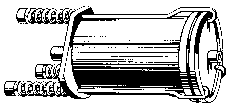
Jetex Jetmaster
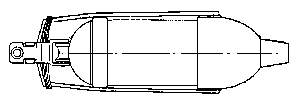
Jet-X 100z
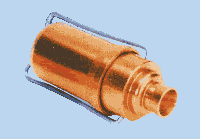
General Description
It is only because of
their similar model numbers that we collect
these disparate engines on the same
page.
Jetex 100 was among
the three motors first introduced, back in June
1948. The 100 has a distinctive 3-spring
design, not found on other motors. (The
350/600A uses 5 springs.) The original Jetex
100 was produced through the end of 1953, when
it was superseded by the more convenient
Jetmaster.
The Jetex Jetmaster
is also distinctive in shape, quite unlike all
other models. The Jetmaster replaced the
earlier, more difficult to open and close, 100
3-spring model, which was discontinued at the
end of 1953.
Now the Powermaster
Jet-X 100-series engines continue the mid-size
engine line. The Jet-X 100Z Mk II is a
light-weight version of the Powermax
100Z.
Historical Notes
The Jetex 100 model
was among the first introduced, in June 1948
(along with the 200). It was fabricated of
turned aluminum alloy, and had a rather
elaborate sping closure. That early model,
which had three coil-springs, each tensioning a
clip-on rod to seal the aft closure (a flat end
cap, with screwed-in jet nozzle), in no way
resembles the newer Jet-X 100 number models.
Loading that original motor is accomplished by
compressing each spring, with a special tool
supplied with each unit, which enabled the hook
on the end of the wire to be lifted clear of
the lip on the end cap. The troublesome spings
(difficult for loading and unloading) gave a
higher sealing pressure.
Thrust on the
original Jetex 100 averages over 1 ounce [28
gm], with an end surge of 1-1/2 to 1-3/4 ounce
[43 to 50 gm], with standard (pre-Red Dot)
fuel. Effective duration is about 15 seconds.
With Red Spot fuel, average thrust is increased
to 1-1/4 ounce plus [35+ gm], with effective
duration cut to 12 seconds. This model was
produced until late 1953, when it was
superseded by the more convenient (and
appreciably more powerful)
Jetmaster.
Because reloading the
original Jetex 100 motor, with its multiple
coil springs and locking rods, was so
difficult, Wilmot & Mansour introduced a
new, simpler model called the Jetmaster in June
1952. The Jetmaster uses standard 100-size
propellant, yet produces about 75% more thrust
than its predecessor. (The Jetmaster is from
time to time referred to as the "Jetmaster
150," perhaps due to its increased thrust.
Since this creates confusion, we have
classified the Jetmaster here with the other
100-size Jetex engines.)
The Jetmaster
features an extended cap, designed expressly as
a matching fit to an augmenter tube.
Particular care was also given to the design
and shape of the combustion chamber, with
plenty of free space, and the venturi section
employed for the jet
nozzle.
The Jetmaster is also
more simple than the 100 for loading, etc., but
features more parts for disassembly when
cleaning and calls for a special tool for
cleaning the jet nozzle, worked from each end
in turn.
Jetmaster engines
became one of the most popular units for
contest work.
Remarks
The Jetex 100 (old)
motors could hold only one propellant
pellet.
Loading the Jetmaster
is much more simple than the early 100.
Instead of three compression springs, the end
cap is held in position by a wire saddle
tensioned with six leaf springs. The end of
the saddle is fitted with a roller which
enables the complete unit to snap off
sideways. No special tool is
required.
The Jetmaster could
hold one or 1-½ pellets, of either
standard or Red Spot fuel. Average thrust with
Red Spot fuel is consistently in the order of
1-7/8 ounce [25 gm], peaking to 2-1/4 ounces
[64 gm] at the end of the run. Effective
duration is some 10 to 12 seconds. With
standard fuel, average thrust is 1-3/8 ounces
[39 gm], peaking to 1-3/4 to 2 ounces [50 to 57
gm]. Efffective duration in this case is
around 15 seconds.
"Wick injection" is
essential for success with the Jetmaster
engine. This engine's nozzle must be cleaned
carefully following each flight. If not so
cleaned, then there is a very real danger of
the fuse core jamming in the nozzle and
blocking the jet, instead of being ejected.
Cases have split when this was not
done.
Many fliers consider
the Jetmaster "original" mounting clamp
unsatisfactory, since it is not very secure,
and no guarantee of consistent thrust line
settings. Many built their own custom mounts
for the Jetmaster.

A "home built"
replacement for the factory-issue Jetmaster
engine clamp
The Jet-X 100Z model
holds up to 4 propellant pellets. Powermax
includes this note with the new Jet-X 100Z
engines: “It is possible to test fly
with one, two, three or four pellets. If the
first pellet to be put in is squashed into the
shape at the bottom of the motor with a piece
of dowel and the three other pellets are put in
normally, the result will be a boost at the end
of the flight.”
Powermax includes
these specific instructions with each new Jet-X
100Z engine: “Load one, two, three or
four pellets depending on flight time
required. Bed down fire resistant washer by
rotating engine body back and forth on jet cap,
applying pressure until a continuous ring
appears on the washer. This will ensure the
best seal. We do not recommend using oil of
any kind on this washer, although we are not
averse to a smear of graphite
grease.”
“The reinforced
washer is slightly tapered. Push it into
position with the smaller end first. Now load
fuse as in picture, making sure fuse is pushed
tight on to the pellet. Clean out groove
thoroughly after each flight. Bed nozzle into
thrust seating washer by pressing down and
twisting till a bright ring appears on fire
resistant
washer.”
Suitable Model
Aircraft
Data posted in green
is from original factory packaging and
instruction sheets
|
|
Jetex 100
|
Jetmaster
|
Jet-X 100Z
|
Wingspan (in)
[cm]
|
18-25
[46-64]
|
20-30
[51-76]
|
<36
[<96]
|
Wing area
(in²)
[cm²]
|
|
|
|
Weight (max,
oz)
[gm]
|
3-4
[85-113]
|
4.0 (6.0 with augmenter
tube)
[113] [170 with augmenter
tube]
|
5
[180]
|
Performance
Specifications
Data posted in green
is from original factory packaging and
instruction sheets
SI (metric) units
provided in brackets
Data in red indicates
extrapolated information, and must be regarded
as approximate, at
best
|
|
Jetex 100
|
Jetmaster
|
Jet-X 100Z
|
Jet-X 100Z Mk
II
|
|
Thrust (avg, oz)
[gm]
|
1.0-1.25
[28-35]
|
1.75
[50]
|
2.0
[56.7]
2.8 [79]
|
2.8 [79]
|
|
Thrust (max, oz)
[gm]
|
2.0
[56.7]
|
2.25
[63.79]
|
6.1 [173]
|
6.1 [173]
|
|
Thrust w/AT¹ (nom, oz)
[gm]
|
Not suitable
for augmenter tube, due to shape and
configuration
|
2.25
[64]
(2.5 w/AT of 13")
[71 w/AT of 13"]
(2.75 w/AT of 5")
[78 w/AT of 5"]
|
|
|
|
Duration
(sec/pellet)
|
14-15
|
20
|
7
|
7
|
|
Duration (max, sec)
|
14-15
|
22 (1½ pellets)
|
15-26
20 (3 pellets)
|
20 (3 pellets)
|
|
Weight (dry, oz)
[gm]
|
0.625
[17.72]
|
0.75
[21]
|
0.67
[19]
0.705 [20]
|
0.635 [18]
|
|
Weight (full, oz)
[gm]
|
0.875
[25]
|
1.3
[37]
|
0.846 (3 pellets)
[24]
|
0.776 oz (4
pellets)
[22]
|
|
Propellant (min, oz)
[gm]
|
0.25
[7.1]
|
0.25
[7.09]
|
0.047 [1.33]
|
0.047 [1.33]
|
|
Propellant (max, oz)
[gm]
|
0.25
[7.1]
|
0.25
[7.09]
|
0.35
[10]
|
|
|
Total impulse (oz-sec)
[N]
|
14-18.75
[3.9-5.2]
|
35-39
[9.7-10.7]
|
|
|
|
Specific impulse (Isp,
sec)
|
56-75
|
140
|
|
|
|
Propellant mass
fraction²
|
0.71
|
0.58
|
|
|
|
Length (in) [cm]
|
0.156
[0.397]
|
3.0
[7.62]
|
2.48
[6.3]
|
2.48 [6.3]
|
|
Width (max, in) [cm]
|
1.00
[2.54]
|
1.1
[2.8]
|
0.945
[2.40]
|
0.945 [2.40]
|
|
Chamber ID (in) [cm]
|
|
|
0.728 [1.85]
³
|
0.728 [1.85]
|
|
Throat (in) [mm]
|
|
|
0.03937 (1.0 mm)
|
0.03937 (1.0 mm)
|
|
Burn surface (nom, in²)
[cm²]
|
|
|
0.413 [2.66]
|
0.413 [2.66]
|
|
Operating pressure (psia)
[atm]
|
|
|
|
|
1:
With augmenter tube
2:
A good rating of motor efficiency, being
propellant weight divided by loaded motor
weight
3:
Powermax Jet-X 100Z pellets are specified by
manufacturer as being 19.3 mm in
diameter
Additional
Illustrations
Jetex 100
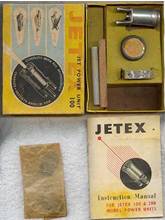 
An
original Jetex 100 kit (click to see larger
images)
Jetex Jetmaster
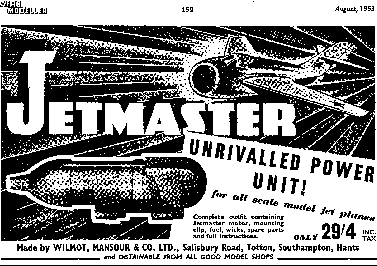
We think this is the
first Wilmot, Mansour ad for the Jetmaster, in
Aeromodeller,
Aug 1953. Can anyone
find an older Jetmaster
ad?
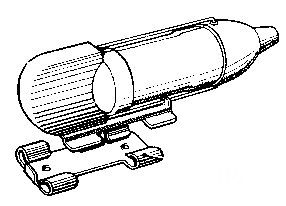
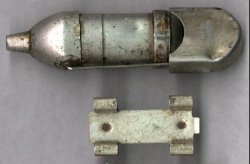
Jetmaster 100, with clip

Note that the Jetmaster has a
"genuine" rocket nozzle, with both a
convergent and a divergent section. The
divergent exit cone increases the thrust
a little.
|
 ...... ......
The two pages of Jetmaster original
instructions may be seen here. Click either
image to enlarge to full size. Page 2 shows
the special Jetmaster cleaning tool, and
describes how to increase thrust duration by
modifying the fuel pellets.
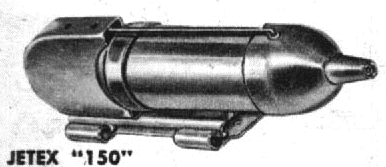
This appears to actually be a Jetex
Jetmaster "100;" perhaps this is a
misprint.
Powermax Jet-X
100
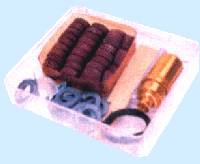
This handsome "Anniversary Kit" was
packaged by Powermax in celebration of
the 50th birthday of Jetex. It holds a
golden anodized Jet-X 100Z engine,
propellant, fuse, and spare sealing
washers.
|
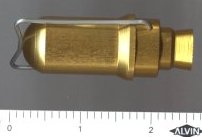
Jet-X 100Z engine, approx actual
size
|